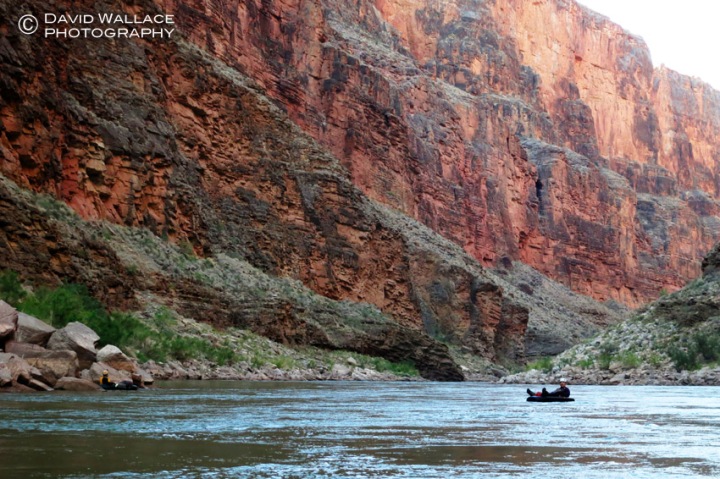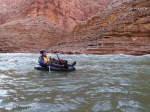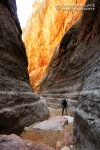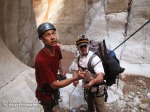Deep in the Big Ditch Day 4 – Floating down river & ascending 150-Mile Canyon
A different sort of day this one. For starters, it begins by water not land with a nearly five mile float down the Colorado River. After spending three days battling immense and uneven terrain slowly and tediously by foot, heavy loads on back, this portion of the trip represents the sweet reward for our toils. The mighty Colorado does the work as we sit back and seamlessly watch the world from 5000 feet below, sail by. So excited, I inflated my packraft the night before. Besides what would make a better pillow. In the morning I wake to discover my “pillow” is a third deflated. I am unable to locate the slow leak in the nearby pool at the bottom of the trickle waterfall at Olo Canyon. I can only hope the leak is so slow it will not too greatly effect the seaworthiness of my vessel. We walk across the beach, backpacks around one shoulder and packrafts and paddles held in the other hand. Life vests are strapped down and packrafts tempered to the 46 degree temperature of the water for maximum inflation. I clumsily board my little boat, my backpack on my lap, my lanky legs hanging out of the sides. I dig my “spatulas” into the water and sand and away we go.
Being so low in the water you feel every undulation, riffle, current and eddy. Its power remarkable. We keep the boats straight and true through the first set of riffles and the water calms. We can relax as the river takes us like a tracking shot on a camera mounted dolly through this magnificent scenery. A herd of maybe 10 big horn sheep run on the rocky slopes above the banks of the river along with us for nearly a mile.
It is not entirely a free ride even on the calm water. Currents can come out of nowhere and it would not take much to eject us from our tiny and flimsy boats. Taking a swim in the 45 degree water would be very serious. As we hear the approaching Matkatamiba rapid we move closer to the north shore. Just before the rapid (we decided earlier in the trip not to run it after scouting it) we dock in individual pockets between shoreline boulders. We exit our boats and portage around the rapid, reentering the river in the riffles just below. We float by a rafting party breaking camp at the Matkat Hotel. I want to say they look at us with perplexity, but they are too far away and I can’t see beyond their waves. Four and a half miles is over very quickly and we leave the marine world behind to return to that of feet on rock and dirt.
150-Mile Canyon, 3BVI
Grand Canyon National Park
05/04/13
A break in the cliffs allows us a layer several hundred feet above the shoreline. At times we use existing bighorn trails, at others we negotiate exposed, chossy and off-camber terrain as we negotiate down river to get into 150- Mile Canyon via a ledge above the Muav Narrows. The ledge is also somewhat precarious forcing us to our bellies in one place to negotiate the narrow ledge maybe a 100- feet above the canyon bottom. Once on solid ground in the bottom of 150- Mile Canyon we begin heading up-canyon for our ticket out of here. The drops that we rappelled on the way down will either be bypassed using shelves above the narrows or we will have to ascend using the rope we left behind.
After a long a bypass hundreds of feet above the narrows below we drop back down to the canyon bottom. At the next dryfall we reach the first set of cord left behind. Instead of leaving a rope at each of the drops, lighter parachute cord was left behind. We attach our rope to the cord and pull the rope into place so we can ascend the drops. To save weight we brought only two sets of ascending gear between the five of us. After the first jug we break into teams to tackle the next three ascents, all of them featuring awkward boulder chokestones at the top that are challenging to get above and around. The jugs are separated by beautiful narrows in shifting light that because of our direction of travel look entirely different than on the way down. The final obstacle out of the Redwall narrows features an exposed but not too difficult 100- foot climb. Shortly after topping out on the rim of the Redwall, I hear Mark who is ahead shout something. I can not make out the words. I then immediately see a Bighorn Sheep sprint right past me right on the edge of the cliff into the narrows.
The Bighorn close encounter was one last treat before the three hour, 2000 plus foot slog to the rim above, much of it in the full force of the afternoon sun. The accumulation of the last four days is being felt now. Nothing to do but put one foot in front of the other until you are there. Upon reaching our vehicles Brian, Cody and Mark make preparations to hit the road and try to make it to Kanab before all of the restaurants stop serving dinner. Eric and I, on the other hand came prepared, having brought food and beer that remarkably is still ice cold in our coolers left behind. Our plans include eating mass quantities of food, washed down with a few brews and then sleeping. Driving can wait until tomorrow. With hugs goodbye, the team separates. Eric and I mosey over to a massive vista of the Grand Canyon landscape below. We marvel at its size. Though we just explored a considerable chunk of this wilderness it is a a mere drop in this truly grand bucket.
-David
- Eric carries his packraft to the river.
- Mark floats down the Colorao River.
- David takes on some riffles.
- Cody and Eric use a bighorn trail above the Colorado River.
- Eric ascends a drop.
- David ascends a drop.
- Mark ascends a drop
- Brian walks through the Redwall narrows.
- Cody jugs as Mark looks on from above.
- Brian bridges to stay dry.
- Eric in beautiful narrows and beautiful light.
- Brian and Eric climbing up narrows.
- Cody ascends another drop.
- David free climbs out of the Redwall.
- A bighorn sheep runs right past us on the rim of the Redwall.
- The upper reaches of 150-Mile Canyon.
Christening “Grand Canyoneering” in Cove Canyon
Cove Canyon, 3BVI
20.6 miles
Grand Canyon National Park
10/15/11 – 10/16/11
.
Before we get started I have to make mention that this recent descent of Cove Canyon in a remote part of the Grand Canyon National Park would almost certainly not have occurred without the new guidebook, “Grand Canyoneering” by Todd Martin. The book takes a look at over 110 side canyons of the Colorado River between Lake Powell and Lake Mead, the majority of which are technical. To say that this book is merely impressive would be a gross understatement. The route descriptions, maps and other relevant information that gives the descents a geologic and technical context are thorough and detailed. The book is also chock full of beautifully printed, informative images. Perhaps even more impressive than the book itself, is the systematic exploration that Todd Martin, his primary partner, Rich Rudow and others involved, accomplished. It is highly probable that a considerable number of these canyon descents were the first time that human beings set foot on that ground.
Though not the deepest canyon in the world, the massive size and scope of the Grand is unparalleled. It is 15 miles at its widest point and 6,000 feet at its deepest. Just walking down from the rim to the river and back to the rim on a well groomed trail is a challenging physical test. Now imagine walking great distances from your car park over uneven and exposed terrain just to locate a side canyon. Once you have reached this canyon you must use a number of technical techniques and gear to reach the Colorado River. Once at the river you are challenged with task of traveling to a place where you have the ability to climb out from the bottom of the Grand Canyon and back to the rim. Armed with complete information from “Grand Canyoneering” or even nuggets of information as I have done on several previous descents of technical side canyons of the Grand Canyon are adventures that require an intense physical commitment and acceptance of suffering.
First descents or completely unbetaed descents are another ballgame, entirely. From a mental standpoint you are faced with the reality that you just don’t know what kinds of of obstacles, technical or otherwise you will face in the canyon. Because of that reality you must take the kitchen sink of technical gear to safely overcome those myriad of unknown obstacles. Todd and Rich were carrying often far more gear than they needed because they just didn’t know. They also probably didn’t know how long exactly a journey to the river and back would take. This means taking some semblance of camping gear and extra food. With the hog on the back, all of their efforts were completed at a frenetic and what some might call, obsessive pace. They spent over 150 days in the Grand Canyon in just 3 years. If you spend that much time in a place in such a short time then you are bound to experience some extreme temperatures, which the Grand can dish up even during the more temperate Spring and Fall seasons. Believe me when I say, having now descended Cove Canyon and a number of others from before the publication of this book, that spending that amount of time in this wilderness in this fashion is almost unimaginable, both physically and mentally. I would like to congratulate Todd and Rich for their discoveries and accomplishments. I think John Wesley Powell in the very least would be interested and might even be proud.
Now on to our descent of Cove Canyon. The adventure began from the remote Tuckup Trailhead nearly 60 miles from the nearest paved road, where the hike began with a pleasant trail traversing along the Esplanade, 3,000 feet above the Colorado River. The Esplanade is an enormous sandstone terrace below the rim that spans much of the length of the Grand Canyon. All too quickly the trail dissipated and we were faced with picking our way through uneven terrain around numerous side drainages and their many respective fingers until reaching the far upper reaches of Cove Canyon.
One can not hike and explore from the rim of the Grand Canyon to the river without getting a first hand lesson in geology. This is even more apparent when you are not traveling a wide, even and fast moving trail and you are forced to slow down and really experience the rock that surrounds you. Todd’s book goes into a straightforward, yet detailed explanation of the geology of the Grand Canyon. To paraphrase, approximately 5 million years ago the region of the Grand Canyon uplifted different horizontal layers of rock in the same even pattern in which they were laid down as sediment. The Colorado River then began to carve out the Grand Canyon with the assistance of the region continuing to uplift. The side canyons were created from violent weather eroding the side drainages revealing the different layers of rock. Venturing down Cove Canyon each of those unique geologic layers exposes themselves as we moved ever so closely to the roar of the river that opened up this geologic history in the first place.
Cove Canyon began in the Supai Sanndstone layer. We were faced with several rappels through the red rock that dates back to nearly 300 million years ago. With the chossy red sandstone behind us the canyon dropped into the Redwall Limestone forming a tight slot, giving us our first respite from the hot sun. Redwall Limestone and its cousin, the Muav Limestone are the rockstar layers when it comes to canyoneering in the Grand Canyon. Their properties form the tightest and most exciting slot sections of the canyons. The Redwall section of Cove Canyon did not disappoint. A magnificent triple drop rappel along a bend brought us to the heart of this section of narrows. A tense moment ensued when initially we had trouble pulling the rope. Through the use of changing angles, moving down canyon and using a jumar to assist in gaining purchase of the rope, we were able to bring that lifeline down. The canyon then opened up filled with large boulders requiring route finding to pick our way through them. With the hog on the back every teeter tottering misstep drained tremendous amounts of energy.
The canyon dropped into several beautiful sets of narrows in the Muav Limestone layer. At this point in the day we began paying closer attention to the time. Whether or not we were going to reach the river before dark began to seem less and less likely. With that we began pushing hard and taking less pictures as we negotiated more rappels through more layers of rock. As the shadows got darker and cooler in hue we could hear the faint sounds of the river. Those sounds got increasingly louder as a subtle draft of chilly air came up from down canyon. Less than half an hour before complete darkness we reached a small sandy beach along the Colorado to bed down for the night.
Shortly after first light we gathered our gear and inflated our packrafts. The small inflatable boats were our mode of transportation downriver to a point where we could hike out of the canyon and back to our vehicle. To say the float was merely exciting would be an understatement as we had to negotiate several major riffles in what basically amounts to a glorified pool toy. Between my 190 pounds of body weight and all of my gear I was more than exceeding the 225 pound limit of the boat that was probably intended to be used only on still water. Still water this was not and floating low in the water, the riffles would splash over and into my boat even though I was hitting them straight on. Several times I had to catch an eddy, get on shore and dump all of the water out of my boat. One of those eddies was so powerful that I had an extremely difficult time escaping its upstream flow and getting into the downstream current with my flimsy, lightweight plastic paddles.
The roar of Lava Falls, one of the biggest and most notorious rapids of the Colorado was the signal to get off the river where a primitive route up a scree slope through the bands of cliffs would allow us to reach the rim over 3,000 feet above. We docked a quarter mile upstream of the rapid, its roar loud and ever present. We could not see it aside from the occasional violent gush of white water flying well above the horizon line of the river. Before the suffer fest out of the bottom of the canyon, we decided to take a look at Lava Falls from a safe perch above the shoreline. Words do not describe the carnage.
The hike out was what we expected: hot, slow, tedious and exhausting. We each found our own pace, spreading out and battling the ascent. We reached the rim in good time before the final 4.5 mile road walk back to our car.
Canyoneering in the Grand is so much more than canyoneering. In fact it is small part of this place that is so big. Even with the assistance of “Grand Canyoneering” the majority of these descents are not for the faint of heart. I look forward to the many adventures I will experience with the knowledge of this book; those many adventures slowly over a long period of time. 150 days of exploration and adventure in just 3 years; not for me, not in this place.
-David
- Mike looks out from the rim of the Grand Canyon.
- A rattlesnake is seen on the hike up.
- Eric climbs up a scree slope en route to the rim of the Grand Canyon.
- Eric (left) and Mike stand safely above the carnage that is Lava Falls.
- Eric packrafts.
- David smiles during a calm section of the five mile packraft of the Colorado River.
- Mike rappels as Eric looks on in the Muav Limestone layer.
- Eric rappels and Mike hikes down through the narrows of the Muav Limestone layer.
- Eric rappels in the Redwall Limestone.
- Mike (left) and Eric struggle to pull the rope on a triple drop 180- foot rappel with a bend in the canyon. After changing angles, moving down canyon and using a jumar the rope came down.
- Eric rappels down through the Redwall Limestone.
- David rappels through the Supai Sandstone layer in the upper part of Cove Canyon.


































1 comment